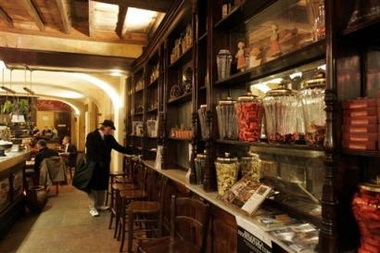|
In Turin, chocolate's the champion
(New York Times)
Updated: 2006-02-15 11:27
Chocolate plus hazelnuts conquered the city, and the combination soon took
definitive shape in the form we know it today, an ingot with a rounded belly,
wrapped in foil. Chocolate-hazelnut paste is tricky to mold, so it was shaped by
hand, and named for the hat worn by the puppet Gianduja, a gluttonous, bibulous
character who was Turin's contribution to commedia dell'arte. The
chocolate-maker Caffarel introduced the candy at the carnival of 1865, and gave
it its name in 1867. Powdered milk became a part of the standard formula after
Daniel Peter discovered the technique for milk chocolate in 1875 and made
Nestlé's fortune.
The creation and its creator are still in place — Caffarel bought the rights
to use the Olympic symbol during the Winter Games here — and chocolate remains
important both as a regional symbol and an employer.

A customer browses
Monday, Feb. 13, 2006, at Abrate, a chocolate and pastry shop in Turin,
Italy, that opened in 1866. Of all the history and culture birthed in
Italy; of all the legendary writers from Dante to Cicero, there is one
edible product that stands tall among them.Chocolate. [AP] |
|
In recent history the carriage-trade chocolatier has been Peyrano, founded in
1915 Four years ago, the Peyrano family scandalized Turin's bon ton by merging
with a Neapolitan family named Maione. (Turin and Naples, both historically
subject to strong French culinary influence, in fact share Italy's most refined
pastry and chocolate-making traditions, but the exuberant character of Naples
could hardly be further removed from the restraint of Turin.)
The box may have lost some of its cachet, but the giandujotti are still
excellent, as a trip to the unchanged, and somewhat dusty, store proved during a
visit in early February as the city was anticipating the start of the Olympics.
Peyrano recently opened a tiny tasting room and shop in an arcade somewhat
hidden in the city's historic center; during the Olympics it offers special
tastings and rich hot chocolate, which the main store has never sold.
Peyrano's "giandujotto antica formula," with bombé base and crinkly foil, has
a higher proportion of hazelnuts than its "giandujotto nuova formula," which has
cocoa butter added for easy machine molding and smooth wrapping. The old formula
has a slight smokiness that Dr. Mariella Maione, in charge of marketing, says
comes from the olive wood the company still uses to roast chocolate. The
"antica" provides a definitive taste, with a satisfying amount of grit and a
lingering aftertaste of fruit and roasted nut. It also has no milk — the
dividing point in the modern giandujotto competition.
"When people ask me the secret of our giandujotto," said Dr. Maione, who
moved from Naples to Turin when her father became part of the business, "I tell
them there's only one: Torino."
|